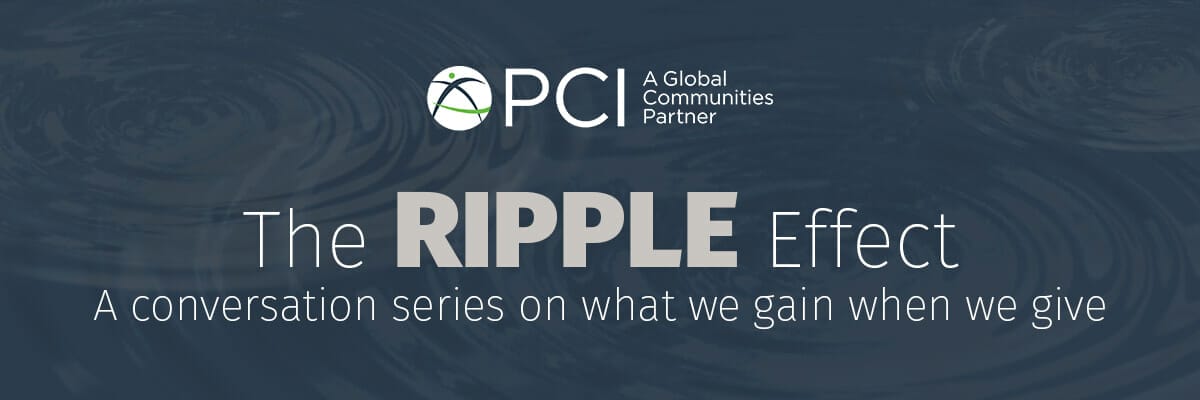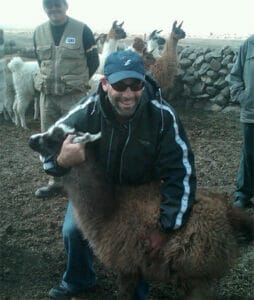News > Blog
Painting it Forward with Eric Sanders
Published 11/13/2020 by Global Communities

By Maureen Simpson
Eric Sanders is no stranger to the concept of ‘return on investment,’ having spent more than 30 years as a successful entrepreneur in the manufacturing industry. Still, when the California-based businessman started shifting his focus toward philanthropy, he never imagined it would also help him recover a long-lost passion.
“I knew there was a space that I wanted to fill in my life, but I just couldn’t figure out what to fill it with,” Sanders said of his journey toward establishing the Sanders Family Philanthropic Foundation, a nonprofit charity that supports Global Communities and PCI, a Global Communities Partner, among other international development and humanitarian assistance organizations.
After years of providing generous financial contributions and sound business counsel to both entities, Sanders has added selling his original art to his palette of philanthropy. In our new Q&A series called “The Ripple Effect,” learn more about the entrepreneurial artist’s connection to PCI and painting.
This interview has been edited for length and clarity.

Eric Sanders
I know your background is in business, but there is so much more to your story than that. How would you introduce yourself to people who might be learning about you for the first time?
I guess the order of operations, to use mathematical jargon, is that between businessman, philanthropist and artist, artist was the first stop. My father was a very good artist. His paintings were hanging all around our house, and they definitely had an impact on me. He started teaching me how to paint when I was six years old, and that’s what got me hooked. To this day, the smell of turpentine really transports me back to my youth, and that was my first stop in my evolution as a person.
Knowing that you continued to paint well into college, before eventually taking a 30-year hiatus, what was the second stop on your journey?
I really appreciated my father’s sort of developmental approach to education. He very specifically said, “I want you to get an education and not a vocation.” The vocations that I was leaning towards were law and business, so I chose philosophy because it was an equally well-positioned platform for going in either direction.
I took my GMATs and did quite well. I also had good grades, so I was in a good position to get an MBA. But before I applied and went to business school, I decided I was going to take a break and travel for a year. I had already purchased my ticket for this world trip when my father approached me to work for him at a manufacturing business he had purchased in California. At the time, I think he saw it as some form of an MBA.
I had very little confidence in the fact that this was going to be a long-term thing, but in June 1985, I got on a plane and came out here knowing nothing about running a manufacturing business. My sole undergraduate exposure was one course in economics, and my father gave me a two-week training course at his manufacturing business in New Jersey.
At what point did you know you were on a career path instead of biding time for that world trip you had planned?
I was 21 when I started, so I jumped in and made all kinds of mistakes. Even though it was a very steep learning curve, I picked up things fast. It was pressure from day one to be successful. Several months in, I came back from a tour of seeing some of my customers to get a direct understanding of what we were doing well and where we could improve when my father surprised me and offered to sell me the business. Having done a forensic analysis of all the different departments and identifying one that was incredibly profitable and easier to manage, I asked if I could buy just part of the business. He said yes. That was my first major taste of being on my own. Within a year, when I finally got all the bugs worked out, which were pretty painful, I felt ready to expand and approached my father about buying the rest of the business. Because I was very young when I acquired my first business, it felt very comfortable and natural for me to acquire other businesses, figure out how to consolidate them and restructure them in ways to make them profitable. I just kept replicating that. Over the next 30 years, I bought 15 companies and grew from four employees to 600.
When did your focus on philanthropy become part of the picture?
Fast forward to the mid-90s, and I was doing a lot of personal development work. I was studying about being the best person you can be and getting the most out of life. I started to understand that there was this whole piece to becoming a well-rounded individual called “self-actualization.” At first, although I was familiar with the term, I didn’t understand anything about it. I kept researching, and I realized that you could do it through religion or raising children or a lot of other ways. However, it was my personal interpretation that the best way to access self-actualization is through philanthropy. After a lot of research and networking, I was introduced to Valerie Jacobs, who advises family foundations and is the wife of Norm Hapke, a former PCI board member. She offered her consulting services and helped me develop sort of a matrix that identified where certain categories of philanthropy overlapped with interests of mine.
During that process, what were you were looking for in terms of a philanthropy match?
I learned that I’m interested in things that are sustainable. In business, when I would fix some major issue or systemic problem and then two years later the same problem was going on, it just drove me crazy. I don’t want to do things that are temporary Band-Aids. I was also interested in international development. The idea of getting $10 of impact for $1 of social investment really resonated with me. I didn’t want to just write checks. Because I ran a business, I wanted to literally go out and see the programs and have a personal understanding of how my investment, my funding, was being utilized as opposed to sitting in a board room and getting a PowerPoint presentation. I wanted to get out in the field and see how and where the work was being done. I wanted to be engaged in the process.

Over the course of his partnership with PCI, Eric Sanders has visited programs in Bolivia, Nicaragua, South Africa and India.
When and how did you become connected with PCI?
I actually planned one trip where I went out in the field with two different organizations, one of them being PCI. I spent a week in Peru with World Neighbors and then they handed me off to PCI in La Paz, Bolivia. I greeted George Guimaraes (former President & CEO of PCI) coming off the plane. That was the first trip, and it was tough. It was physically very taxing, because we were up in the Andes at about 10,000–feet altitude most of the time. I certainly came away having a very fundamental understanding of PCI’s programs.
What did you experience in Bolivia, or elsewhere with PCI, that really moved you and made you feel like you found an organization that connects to your vision for philanthropy?
It’s so emotional, it’s almost difficult to talk about, even though it’s probably been over 15 years ago now. When I was visiting Bolivia, I had young kids of my own, and we went to a school where the floor was made out of stones. It was such a primitive little hovel of a school in a tiny rural community, but all around the room were their little drawings. It was exactly like an American kindergarten classroom, except it was in a very, very poor environment. It just struck me that these are kids just like my kids, but this is the environment that they’re growing up in. I wanted to be able to do more for them.
You talked about wanting to bring your business sense and perspective into your philanthropy work, but when did art become part of your approach as well?
I sold my business seven years ago. It happened well before I thought it would, but it was something I was very much looking forward to happening. Then I was stuck with this fantastic problem of “Now what do I do?” I was kind of feeling lost and not sure where to go. Then three years ago, on my birthday, my girlfriend, Anna, gave me a set of paints – three colors – white, blue and black, one paintbrush and a pad of paper. I hadn’t painted in over 30 years, so I thought all those skills I had developed were gone. I was strongly under the impression that creativity was something that young people had, like muscle tissue, and the older you get, there’s less and less of it. But I started painting anyway, and I was surprised that I was able to get back to the same level of technical skill that I had in college.
From that little set of paints, I bought another brush and then I bought some other colors, and then I just kept growing and growing. I painted for a couple years before a close friend of mine who is an interior designer suggested I start selling my work. At first, I said, “Absolutely not. I’m doing this for fun, and I don’t want to turn it into a job.” He kept persisting and when we were out to dinner one night, he said, “If the stumbling block is that you don’t want it to be about making money, why don’t you do it for charitable reasons?” That’s when the light bulb went off, this idea of merging these two really big passions and interests I have together. For the last three years, I’ve been going down that path and basically have an art business that is pushing my work out and creating revenue that goes back to my foundation. I’m on track this year to sell about $25,000 of artwork. It’s a good start.
Earlier, you talked about how your approach to business and even to philanthropy is very analytical. What is your process like with art?
Well, it turns out that a lot of artists are very analytical, and some of the best artists are extremely analytical. Unless you take the extra time and energy to invest in really understanding the work at a granular level, you wouldn’t know what the analytical elements were that went into a piece being that powerful. So, these qualities are actually not incompatible like ketchup and chocolate. They’re very synergistic in creativity. Fortunately for me, it’s more of an asset and not something I have to overcome.
For me, it’s fascinating to basically start a whole new career and to have a 35-year career path to kind of benchmark myself against. To say, “OK, where was I when I was 24, 25? What did I know about my business?” Even though they’re totally different, there’s a lot of comparable benchmarks of progression and development, so that’s been fascinating for me to track as well.
How would you describe your art?
I decided to focus on abstract because figurative painting felt like way too high a mountain to scale when I was just putting my rock climbing boots back on after a long break. Of course, once I got into it, I realized that abstract painting is far more complex and difficult than I realized that it was. There‘s so much to it, so I’m enjoying being wrong about it and love that there’s so much to learn. For the last year, I’ve also been struggling to pick up figurative painting and taking lots of lessons. Now I’m starting to incorporate figurative elements into my abstract paintings, which is kind of an interesting blend.

In addition to PCI, I know you have been a strong supporter of Global Communities for a number of years. Since you have such a unique thread and view into both organizations, what do you think of the recent merger?
I entirely back it, because there are too many mid-size nonprofits doing the same thing, or at least a 75-85% overlap in a shrinking pool of funds. When PCI first started talking to Global Communities, I knew from the beginning that it was such a logical fit. I know both organizations’ programs at a very granular level, and they complement each other beautifully, both in geography, scope and focus. Also, I thought Global Communities was at an organizational stage that PCI was striving to reach and that it could really accelerate that growth path. Whenever my opinion was solicited, I would say, “Yeah, kick that tire hard! I see all kinds of potential there.”
Obviously 2020 has been a challenging year. In many ways and for many people, it’s often felt like the world has lost its color at times. What has kept you motivated or inspired during the pandemic?
Last year, I traveled for four months. You can’t bring your paints and your easel and your studio with you on the road. If anything, this time at home has allowed me to create more work. I go to my studio and paint much more now. It has given me a lot of material, and all my latest work is in some way connected to the pandemic and what I’m experiencing living through it. To me, the pandemic is a perfect thing to tap into and reflect on through art, because there’s no politics to it. It’s quite sincere when you express how you feel about it.
Returning to what you said earlier about your interest in and journey toward self-actualization, do you feel like art—similar to philanthropy—has also been an access point for you?
That question really resonates with me. Yes, now that I’m reflecting upon that, I really do think that being an artist is very much a means to accessing self-actualization. There was a midpoint between selling my business and becoming a painter where I went to my first international art fair called Art Basel in Miami. I saw all of this incredible work gathered in one place, and I really started to form an understanding of how I wanted to engage with the world. It was kind of like going into that schoolhouse in Bolivia. I came out of that experience a different person than I went in. Similar to when I first started learning about philanthropy, I suddenly found myself in this wide open, uncharted territory where I was excited and eager to learn again.
To learn more about Eric Sanders and his artwork, visit www.studiosanders.com.





